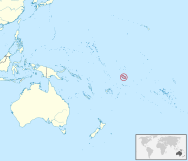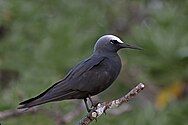Tokelau is a dependent territory of New Zealand in Polynesia in the Pacific Ocean, comprising three coral atolls with a total land area of 10.1 km2 (3.9 sq mi).[1] There are 33 species of birds that have been recorded from Tokelau, of which one, the red junglefowl, has been introduced by humans. Anas ducks are also seasonal visitors to the islands.[2] The most common species in Tokelau are the black noddy, brown noddy, and white tern, which each have populations of thousands of pairs on each of the atolls.[2] Three species of birds found in Tokelau, the bristle-thighed curlew, bar-tailed godwit, and flesh-footed shearwater, are near-threatened.[3][4][5] One species, the Australian masked-owl, is locally extinct. Before the arrival of humans, Tokelau may also have been inhabited by Halcyon kingfishers, Gallirallus and Porzana rails, Acrocephalus warblers, Aplonis starlings, Prosobonia sandpipers, and fruit doves.[1]
Tokelau has a moist tropical climate year-round, with an average temperature of 28 °C (82 °F) and a mean annual rainfall of over 3,000 mm (120 in). The atolls consist of coral rubble of different sizes, with poor quality soil overlying coral rock. Plant diversity is low, with forest on the inner side of the atolls comprising mainly coconut palm, along with other tropical trees like Cordia subcordata, Pisonia grandis, Guettarda speciosa, and Pandanus. Undergrowth mainly consists of bird's-nest fern (Asplenium nidus). Vegetation nearer the beach is more diverse, with very little soil and plants like Scaevola taccada and Morinda citrifolia.[6]
This list's taxonomic treatment (designation and sequence of orders, families, and species) and nomenclature (common and scientific names) follow the conventions of the 2022 edition of The Clements Checklist of Birds of the World. The family accounts at the beginning of each heading reflect this taxonomy, as do the species counts found in each family account. Introduced and accidental species are included in the total counts for Tokelau.
The following tags have been used to highlight several categories. Not all species fall into one of these categories. Those that do not are commonly occurring native species.
- (A) Accidental – a species that rarely or accidentally occurs in Tokelau
- (I) Introduced – a species introduced to Tokelau as a consequence, direct or indirect, of human actions
- (Ex) Extirpated – a species that no longer occurs here although populations may exist elsewhere
- ^ a b Steadman, David W. (2006). Extinction & biogeography of tropical Pacific birds. Chicago: University of Chicago Press. pp. 282–283. ISBN 0-226-77141-5. OCLC 62172698. Archived from the original on 16 April 2022. Retrieved 14 April 2022.
- ^ a b Cite error: The named reference
:1was invoked but never defined (see the help page). - ^ BirdLife International (2017). "Limosa lapponica". IUCN Red List of Threatened Species. 2017: e.T22693158A111221714. doi:10.2305/IUCN.UK.2017-1.RLTS.T22693158A111221714.en. Retrieved 16 April 2022.
- ^ BirdLife International (2020). "Numenius tahitiensis". IUCN Red List of Threatened Species. 2020: e.T22693182A181357867. doi:10.2305/IUCN.UK.2020-3.RLTS.T22693182A181357867.en. Retrieved 16 April 2022.
- ^ BirdLife International (2019). "Ardenna carneipes". IUCN Red List of Threatened Species. 2019: e.T22698188A155469189. doi:10.2305/IUCN.UK.2019-3.RLTS.T22698188A155469189.en. Retrieved 16 April 2022.
- ^ Abbott, K. L.; Sarty, M.; Lester, P. J. (2006). "The ants of Tokelau". New Zealand Journal of Zoology. 33 (2): 157–164. doi:10.1080/03014223.2006.9518440. ISSN 0301-4223.

